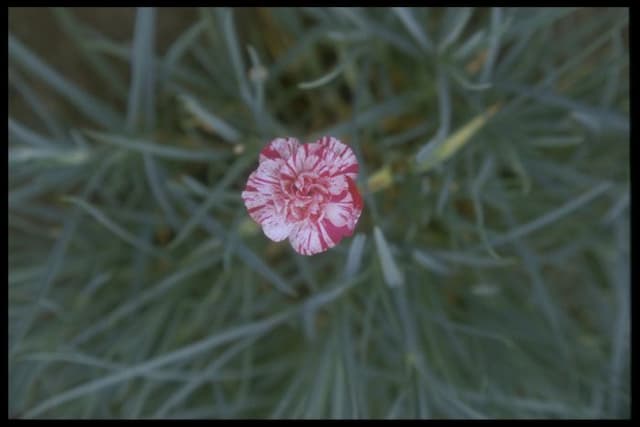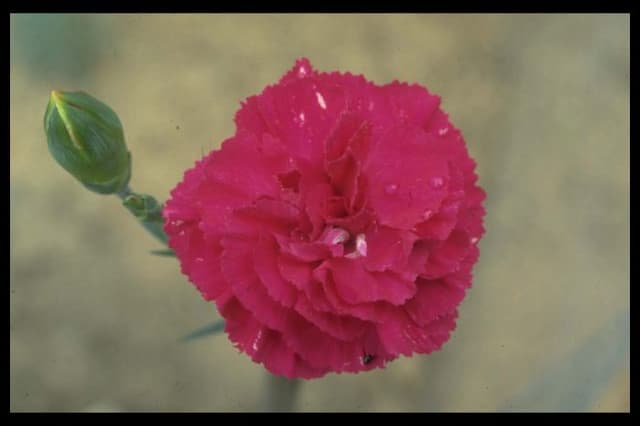Carnation Dianthus 'Prado' (pf)

ABOUT
Dianthus 'Prado', commonly known as pinks or carnations, is recognized for its striking flowers and lush foliage. The plant bears an attractive mound of slender, blue-green leaves that provide a lovely contrast to the vibrant hues of the blossoms. The flowers themselves are notable for their frilly, often serrated petal edges, which give them a quaint, ornate appearance reminiscent of historic gardens. The blooms range in color from deep pinks to reds and sometimes have a two-toned pattern, with different shades accentuating the petal edges or the center. The flowers are typically small to medium in size and can have either a single layer or multiple layers of petals, contributing to a full, ruffled look. Each flower is centered with a cluster of contrasting stamens that add to the ornamental appeal. This plant also emits a sweet, spicy fragrance that is particularly pronounced during the warmer parts of the day or when basking in the sunlight. The aroma attracts pollinators such as bees and butterflies, adding another layer of interaction with the environment. Dianthus 'Prado' blooms profusely over the growing season, and if deadheaded, it will often reward gardeners with multiple flushes of flowers throughout the year. While this plant makes a statement in garden beds and borders, it is also well-suited for container gardening, where its showy flowers can be appreciated up close. Despite its delicate appearance, Dianthus 'Prado' exhibits a hardiness that makes it suitable for various growing conditions, provided it is planted in well-draining soil and receives ample sunlight. Its blooms are also utilized in cut flower arrangements, where they add a traditional and romantic flair.
About this plant
 Names
NamesSynonyms
Carnation, Pink
Common names
Dianthus ‘Prado’.
 Toxicity
ToxicityTo humans
The Dianthus 'Prado,' commonly known as Carnation, is generally considered to be non-toxic to humans. However, ingesting any part of the plant can potentially cause mild gastrointestinal discomfort in some individuals, such as nausea or vomiting, due to its somewhat bitter taste and the presence of saponins. Saponins are natural compounds that can be found in many plants and can cause minor irritations. It's usually advised to avoid consuming plant parts that are not typically regarded as food, especially in significant amounts.
To pets
The Carnation, or Dianthus 'Prado,' is also non-toxic to pets. This means that if pets ingest this plant, they are unlikely to experience serious illness. Nevertheless, as with humans, ingestion by pets can sometimes lead to mild gastrointestinal upset, including symptoms like nausea or diarrhea. If you notice that your pet has eaten a significant amount of the plant and is showing signs of distress, it is best to consult with a veterinarian.
 Characteristics
CharacteristicsLife cycle
Perennials
Foliage type
Evergreen
Color of leaves
Blue-green
Flower color
Mixed
Height
0-1 feet (0-30 cm)
Spread
0-1 feet (0-30 cm)
Plant type
Herb
Hardiness zones
6
Native area
Europe
Benefits
 General Benefits
General Benefits- Attractive Blooms: Produces vibrant, colorful flowers that can enhance the aesthetic appeal of gardens and landscapes.
- Long Blooming Period: Offers an extended display of blooms, often throughout the spring and summer months.
- Drought Tolerance: Once established, it can tolerate periods of low water, making it suitable for xeriscaping and water-wise gardens.
- Cold Hardiness: Capable of withstanding cooler temperatures, which enables it to thrive in a variety of climates.
- Low Maintenance: Requires minimal care once established, making it a convenient choice for gardeners of all skill levels.
- Attracts Pollinators: Flowers can attract butterflies, bees, and other beneficial insects to the garden.
- Deer Resistance: Often avoided by deer, which helps to prevent damage to the plant and maintain its aesthetic appeal.
- Versatility: Can be planted in beds, borders, containers, and as edging, offering flexibility in garden design.
 Medical Properties
Medical PropertiesThis plant is not used for medical purposes.
 Air-purifying Qualities
Air-purifying QualitiesThis plant is not specifically known for air purifying qualities.
 Other Uses
Other Uses- Dianthus can be used in making natural dyes for fabrics, as the flowers can give off a range of subtle colors depending on the mordant used.
- The petals of the Dianthus can be crystallized with egg white and sugar to create edible decorations for desserts and cakes.
- They can serve as an all-natural confetti at weddings or celebrations, biodegrading more quickly than paper or plastic alternatives.
- Certain species of Dianthus can be used for companion planting to deter pests in gardens, as they can attract beneficial insects.
- The presence of Dianthus in a bouquet can extend the overall life of the arrangement, as they have a relatively long vase life.
- The flowers can be pressed for crafts or to create botanical prints, due to their rich colors and interesting textures.
- In the language of flowers, Dianthus can be used to convey a message of love, fascination, or distinction.
- Cuttings from Dianthus plants can be used in propagation activities, making them a good educational tool for gardening workshops.
- The plant can also be used to create a natural border or edging in garden design due to its compact growth habit.
- Dianthus petals can be incorporated into potpourri mixes for a delightful fragrance that lasts.
Interesting Facts
 Feng Shui
Feng ShuiThe Carnation is not used in Feng Shui practice.
 Zodiac Sign Compitability
Zodiac Sign CompitabilityThe Carnation is not used in astrology practice.
 Plant Symbolism
Plant Symbolism- Love: Dianthus, also known as "Carnation," often symbolizes love and fascination, making it a popular choice for romantic occasions.
- Distinction: The name "dianthus" itself comes from the Greek words "dios" (divine) and "anthos" (flower), suggesting the flower's association with divinity and excellence.
- Boldness: Carnations come in bold colors, which can represent courage and daring, often gifted to convey admiration and a sense of adventure.
- Pure Affection: These flowers can convey pure love and affection, making them a traditional Mother's Day gift or a way to show someone they are cherished.
- Good Luck: In some cultures, giving a carnation can be seen as a gesture of good luck, making them suitable for graduations and new beginnings.
- Gratitude: Different shades of dianthus carry nuanced meanings; for instance, light red signifies admiration, while dark red denotes deep love and affection.
 Water
WaterCarnations require even moisture and should be watered deeply to promote deep root growth, but they do not tolerate wet feet, so ensure good drainage. Water them with about 1 inch of water per week, adjusting for rainfall, and avoid overhead watering to keep the foliage dry and prevent disease. In hotter, drier periods, you may need to water twice a week, while in cooler, wetter conditions, watering once every ten days to two weeks might suffice. Use a soaker hose or drip irrigation to apply water directly to the soil without wetting the leaves. It's important to check the soil moisture regularly and adjust your watering schedule based on the weather and soil conditions.
 Light
LightCarnations prefer full sun with at least 6 hours of direct sunlight daily to thrive and produce the best blooms. They should be placed in a spot where they are exposed to direct, unfiltered sunlight through most of the day. Partial shade is acceptable, especially in extremely hot climates where some afternoon shade can prevent overheating, but too much shade can result in fewer flowers and leggy plants.
 Temperature
TemperatureCarnations enjoy cooler temperatures and typically thrive in a range of 60 to 70 degrees Fahrenheit. They can survive minimum temperatures down to about 40 degrees Fahrenheit and maximum temperatures up to around 85 degrees Fahrenheit. However, prolonged exposure to temperatures outside of their comfort zone can stress the plants and affect their health and blooming.
 Pruning
PruningPruning carnations is crucial to promote bushy growth and abundant blooms. Remove dead flowers promptly, a process known as deadheading, to encourage more blooms. Also, cut back the stems by one-third after the main flowering period is over to revitalize the plants for another bloom cycle. The best time for heavier pruning is in the early spring before new growth begins.
 Cleaning
CleaningAs needed
 Soil
SoilCarnations prefer well-draining, loamy or sandy soil with a pH range of 6.0 to 7.5. For the best soil mix, combine two parts potting soil, one part perlite, and one part compost to ensure adequate drainage and fertility.
 Repotting
RepottingCarnations should be repotted every one to two years to provide fresh soil and more space for growing roots. Typically, they should be repotted in spring before the onset of vigorous growth.
 Humidity & Misting
Humidity & MistingCarnations thrive best in moderate humidity levels; too high humidity can promote disease. Aim for a humidity level around 40-50%.
 Suitable locations
Suitable locationsIndoor
Place carnations in bright, indirect light with ample airflow indoors.
Outdoor
Plant carnations in sunny spot, sheltered from harsh winds outdoors.
Hardiness zone
3-9 USDA
 Life cycle
Life cycleThe life of Dianthus 'Prado', commonly known as Carnation, begins with seed germination, typically taking place in a moist, well-drained substrate in a cool environment. This is followed by the seedling stage, where the first true leaves develop and the plant establishes a small root system. The vegetative growth phase comes next, during which the plant develops a robust root system, foliage, and stems in preparation for flowering. Upon reaching maturity, the Carnation enters the flowering stage, characterized by the development of distinctive fragrant blossoms that may come in a variety of colors, depending on the cultivar. After pollination, the plant produces seeds, completing the reproductive cycle and allowing for the spread of progeny. Lastly, in perennial varieties, Carnations may enter a period of dormancy during colder months, where growth slows down significantly before the cycle commences anew with the return of favorable conditions.
 Propogation
PropogationPropogation time
Late winter to spring
Dianthus 'Prado', commonly known as pinks or carnations, can be propagated most successfully through stem cuttings. This method is popular due to its effectiveness in preserving the characteristics of the parent plant. The best time for taking cuttings is late spring through summer when the plant is actively growing. Select a healthy, non-flowering stem and cut a 4 to 6 inch (approximately 10 to 15 cm) portion just below a leaf node. Remove the lower leaves, dip the cut end into a rooting hormone powder to encourage root development, and plant the cutting in a well-draining soil mix. Keep the soil moist but not waterlogged, and provide indirect light until roots have formed and new growth appears, usually within a few weeks.




![Pink [Coconut Sundae]](/_next/image?url=https%3A%2F%2Fplants-admin.emdemapps.com%2Fimages%2Fplants%2F%2Fimages%2F604b5d09d4fd1.png&w=640&q=75)




